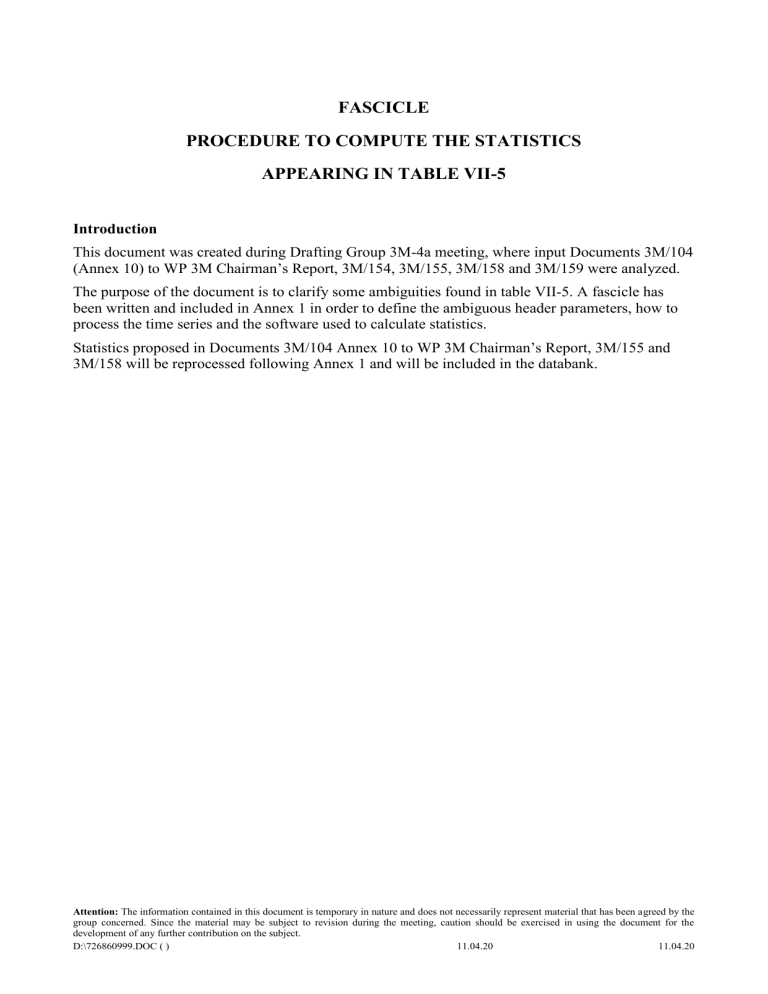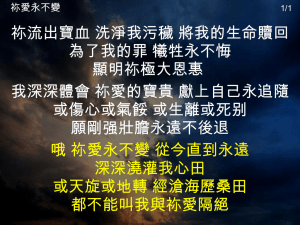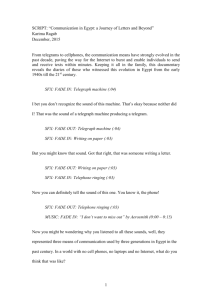Fascicle: Procedure to compute the statistics appearing in

FASCICLE
PROCEDURE TO COMPUTE THE STATISTICS
APPEARING IN TABLE VII-5
Introduction
This document was created during Drafting Group 3M-4a meeting, where input Documents 3M/104
(Annex 10) to WP 3M Chairman’s Report, 3M/154, 3M/155, 3M/158 and 3M/159 were analyzed.
The purpose of the document is to clarify some ambiguities found in table VII-5. A fascicle has been written and included in Annex 1 in order to define the ambiguous header parameters, how to process the time series and the software used to calculate statistics.
Statistics proposed in Documents 3M/104 Annex 10 to WP 3M Chairman’s Report, 3M/155 and
3M/158 will be reprocessed following Annex 1 and will be included in the databank.
Attention: The information contained in this document is temporary in nature and does not necessarily represent material that has been agreed by the group concerned. Since the material may be subject to revision during the meeting, caution should be exercised in using the document for the development of any further contribution on the subject.
D:\726860999.DOC ( ) 11.04.20 11.04.20
- 2 -
3M/TEMP/43-E
ANNEX 1
1
Header parameters
Rx dynamic range: maximum reliable fade value that can be measured by the receiver system.
Rx minimum signal-to-noise ratio: ratio between the lowest measured signal power level and the noise floor level.
Calibration interval parameter has to be replaced by Tx signal bandwidth.
Clarification has been added related to multiple types of environments.
The header parameter of table VII-5 is as follows:
Station number
TX frequency f (GHz)
TX polarization (L/C)
TX polarization tilt angle
p
(degrees)
RX average elevation angle (degrees)
RX rain zone
(1)
Signal source (transmitter on i.e.: satellite,
helicopter, aeroplane, balloon, tower)
If satellite: satellite name orbital position (degrees) E
TX antenna gain towards mobile (dBi)
TX signal bandwidth (Hz)
_ _ _ _ _ _
_ _ _ _ _ _
_
_ _ _ _
_ _ _ _ _
_
_ _ _ _ _ _ _ _ _ _
_ _ _ _ _ _ _ _ _ _
_ _ _ _ _ _
_ _ _
Mobile station
RX site name
RX country (2)
_ _ _ _ _ _ _ _ _ _ _ _ _ _ _ _ _ _ _ _
_ _
RX average latitude (–90..+90) (degrees) _ _ _ _ _ _ _
RX average longitude (0..360) (degrees) E
Average velocity of vehicle (km/h)
RX average altitude amsl h gr
(m)
RX antenna height ag h r
(m)
RX antenna type
RX 3 dB beamwidth in Az
rAz
RX 3 dB beamwidth in El
rEl
(degrees)
(degrees)
RX antenna gain (dBi)
_ _ _
_
_
_
_
_
_
_
_
_
_
_
_
_
_
_
_
_
_
_
_
_
_
_
_
_
_
_
_
_
_
_
_
_
_
_
_
_
- 3 -
3M/TEMP/43-E
RX antenna diameter D (m)
RX radome? (Y/N)
RX polarization (L/C)
RX polarization tilt angle
p
(degrees)
RX multipath reduction? (Y/N)
RX dynamic range (dB)
RX minimum signal-to-noise ratio (dB)
RX integration time (s)
RX bandwidth (Hz)
Data sampling interval (s)
Data resolution (dB)
Measurement: Experiment No.
Start date (yyyy.mm.dd)
End date (yyyy.mm.dd)
Duration of measurement in
this environment (h)
Season
Environment
Land mobile terrain type (3)
Building type
Vegetation type
Surface condition (wet, dry, snow)
_ _ _ _
_ _ _
_
_ _ _ _
_
_ _ _ _ _
_ _ _
_ _ _ _
_ _ _ _
_ _ _ _ _ _ _
_ _ _ _ _ _ _
_ _ _
_ _ _ _ _ _ _ _
_ _ _ _ _ _ _ _
_ _ _ _ _ _ _
_ _
_ _ _ _ _ _ _ _ _ _
_ _ _ _ _ _ _ _ _ _
_ _ _
_ _ _ _
- 4 -
3M/TEMP/43-E
2 Measured time series
Figure 1 Time series measured and shadowing
Fast variations (multipath) are removed from the measured time series to obtain shadowing variations as showed in Figure 1.
The method proposed to remove fast variations is:
- Moment-Method estimation [R1] applied on a 10λ length sliding window
3 Tables
A new table is included to consider the fade depth statistics of the shadowing time series. Two more fade levels are also included in the fade duration tables.
Table a: fade depth statistics of the measured time series
Table b: fade duration statistics of the measured time series.
Table c: fade duration statistics of the shadowing time series
TABLE a
Fade depth (dB relative to LOS) exceeded and XPD (dB) NOT exceeded for percentage of time
0.1 1 5 10 30 50 90 99 99.9 Percentage of time
Fade depth A
XDP
(dB)
(dB)
D:\726860999.DOC ( ) 11.04.20 11.04.20
- 5 -
3M/TEMP/43-E
TABLE b
Fade duration reported in seconds or metres (s/m)
Fade duration (s) or (m) exceeded for percentage of locations at given fade levels
Percentage of locations
0.1 1 5 10 30 50 90
0 0 dB
0 2 dB
0 5 dB
10 dB
15 dB
20 dB
99 99.9
TABLE c
Fade duration reported in seconds or metres (s/m)
Fade duration (s) or (m) exceeded for percentage of locations at given fade levels
0.1 1 5 10 30 50 Percentage of locations
0 0 dB
0 2 dB
0 5 dB
10 dB
15 dB
20 dB
90
References:
99 99.9
Comments:
(1) See Recommendation ITU-R P.837.
(2) See Annex 1 for list of country codes.
(3) See Annex 3 for environment types. Measurements should preferably only cover one type of environment. In case of multiple types, used comments field to specify the environments and their respective occurrences in percents. Also enter the terrain characteristics: FL: flat, HI: hilly,
MO: mountainous (Example: 33, HI means suburban, hilly).
D:\726860999.DOC ( ) 11.04.20 11.04.20
- 6 -
3M/TEMP/43-E
4 Uniform way to compute fade depth and fade duration statistics
Fade depth exceeded for percentage of time
%series: measured power time series (dB relative to LOS) perc=[0.1 1 5 10 30 50 90 99 99.9]; fade_depth=prctile(series,100-perc);
Fade duration exceeded for percentage of time at given fade levels
% The function fade_dur.m computes the fade duration cumulative statistics. function [fd_exc] = fade_dur(series,dd,Athr,perc)
% Inputs :
% - series : measured power time series (dB relative to LOS)
% - dd : distance vector (m)
% - Athr : Fade threshold (dB) Athr=[0 2 5 10 ];
% - perc : percentage of fade duration > computed fade duration
(see Output)
%
% Output : perc=[0.1 1 5 10 30 50 90 99 99.9];
% - fd_exc : fade duration corresponding to perc series = series(:); for ithr = 1:length(Athr)
ideb = find(diff([0;series<=-Athr(ithr)]) == 1);
ifin = find(diff([series<=-Athr(ithr);0]) == -1);
fd_dur = [];
for ie = 1:length(ideb)
if (ideb(ie)>1 & ifin(ie)<length(series))
if not(isnan(series(ideb(ie)-1))) & not(isnan(series(ideb(ie)))) & not(isnan(series(ifin(ie)))) & not(isnan(series(ifin(ie)+1)))
d_deb = interp1([series(ideb(ie)-
1),series(ideb(ie))],[dd(ideb(ie)-1),dd(ideb(ie))],-
Athr(ithr),'linear');
d_fin = interp1([series(ifin(ie)),series(ifin(ie)+1)],[dd(ifin(ie)),dd(ifi n(ie)+1)],-Athr(ithr),'linear');
fd_dur = [fd_dur;d_fin - d_deb];
end
end
end
fd_exc(:,ithr) = prctile(fd_dur,100-perc)';
disp([num2str(ithr),'/',num2str(length(Athr))]) end
To compute the fade duration, the samples that are below the specified fade level are identified and the value that crosses the fade level is calculated by linear interpolation. See Figure 2 . If linear
D:\726860999.DOC ( ) 11.04.20 11.04.20
- 7 -
3M/TEMP/43-E interpolation is not used, and samples under specified fade level are considered a "stairs" effect appears due to the given sampling time/distance. See Figure 3 .
Figure 2 Fade duration using interpolation
Figure 3 Stairs effect
References
[R1]
L. J. Greenstein, D.G. Michelson, V. Erceg, “Moment-Method Estimation of the Ricean
K-Factor”. IEEE Communications Letters, Vol 3, NO. 6, June 1999.
_____________
D:\726860999.DOC ( ) 11.04.20 11.04.20








